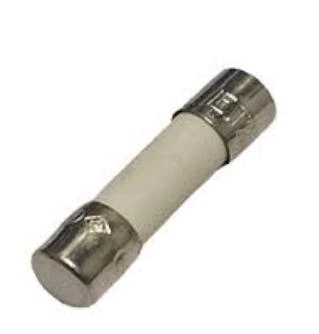Complete Guide To Selection And Application Of Ceramic Tube Fuses

In overcurrent protection for electronic products and electrical systems, the ceramic tube fuse stands out for its excellent high‑temperature resistance, mechanical robustness, and self‑extinguishing properties. Whether in household appliances, automotive electronics, industrial automation, or telecom equipment, a reliable fuse is essential. This guide covers common sizes such as 5×20 mm ceramic tube fuse and 6×32 mm ceramic tube fuse, explains the differences between fast‑acting ceramic fuses and time‑delay ceramic fuses, and provides key selection criteria.
What is a ceramic tube fuse?
Ceramic tube fuses are composed of built-in fuses and ceramic tube bodies, with copper or nickel alloy end caps installed at both ends. When in operation, if the current exceeds its rated value, the internal fuse melts rapidly. The ceramic powder inside the tube absorbs the arc energy and extinguishes the arc, thereby achieving circuit protection.
- Ceramic casing: High-strength insulation, heat resistance, flame retardancy, capable of withstanding the high temperature and electric arc during melting.
- Fuse structure: Different materials (copper, silver alloy or copper-nickel alloy) are selected according to the application to determine the melting characteristics.
- End caps and fillers: The end caps are responsible for electrical connections and are filled with quartz sand or alumina powder to quickly absorb arc energy.

Specifications and Characteristics
-
5×20 mm Ceramic Tube Fuse
• The most widely used standard size for small appliances and light industrial equipment
• Fast‑acting ceramic fuse variants respond within milliseconds to surge currents -
6×32mm Ceramic Tube Fuse
• Higher current and voltage ratings, common in power modules and industrial control panels
• Time‑delay ceramic fuse versions withstand brief inrush currents without nuisance blowing -
High‑Interrupting Ceramic Fuse
• Rated to safely clear high fault currents without damage to downstream circuits
• Often marked “High‑Interrupting Ceramic Fuse” and available with UL/CSA certification
Industry Applications
-
Household Appliances: Refrigerators, microwaves, and televisions typically use 5×20 mm fast‑acting ceramic fuses to protect internal circuits.
-
Automotive Electronics: Engine control units and onboard chargers require 6×30 mm high‑interrupting ceramic fuses that meet automotive-grade standards.
-
Industrial Automation: PLC cabinets and servo drives use time‑delay ceramic fuses to tolerate motor startup currents and prevent false trips.
-
Telecom Power Systems: Base stations and network switches rely on UL/CSA certified ceramic fuses for 24/7 reliability in overcurrent protection.
-
Medical Equipment: Critical healthcare devices demand industrial‑grade ceramic fuses with clearly defined time‑current characteristic curves.
Fuse Selection Guidelines
-
Match Rated Current and Voltage
• Choose a fuse rating equal to or slightly above the circuit’s maximum continuous current
• Select a voltage rating at least 20 percent higher than the operating voltage -
Fast‑Acting vs. Time‑Delay
• Use fast‑acting ceramic fuses for purely resistive loads without startup surges
• Choose time‑delay ceramic fuses for inductive or motor loads to tolerate brief inrush currents -
Interrupting Capacity and Certification
• A high‑interrupting ceramic fuse ensures safe fault clearing at the worst‑case fault current
• Prefer fuses certified to UL/CSA or IEC safety standards -
PCB Footprint and Physical Size
• Follow PCB fuse layout best practices by reserving space for 5×20 mm or 6×30 mm fuse holders
• Allow adequate clearance around the fuse for heat dissipation
Frequently Asked Questions
Q1: Why do ceramic fuses sometimes blow prematurely?
A1: A fast‑acting fuse may blow on normal inrush currents. Switch to a time‑delay ceramic fuse for inductive or motor loads.
Q2: How do I safely replace a ceramic tube fuse?
A2: Disconnect power, remove the old fuse from its holder, and insert a new fuse of identical size, current rating, voltage rating, and interrupting capacity. Inspect the fuse holder for damage.
Q3: What extends the lifespan of a ceramic tube fuse?
A3: Avoid exceeding the fuse’s rated current, maintain proper ventilation around the fuse, and periodically check the fuse holder and contacts for corrosion.
Conclusion
Selecting the right ceramic tube fuse involves choosing the correct size (5×20 mm or 6×30 mm), deciding between fast‑acting and time‑delay types, verifying interrupting capacity, and ensuring proper certification. By following this ceramic fuse selection and application guide, you can provide reliable overcurrent protection across appliances, automotive systems, industrial controls, telecom equipment, and medical devices—maximizing safety, uptime, and performance.